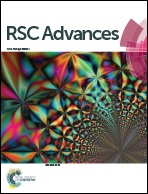Self-healable castor oil based tough smart hyperbranched polyurethane nanocomposite with antimicrobial attributes
Abstract
Here, castor oil-based tough hyperbranched polyurethane/sulfur nanoparticles decorated reduced graphene oxide (HPU/SRGO) nanocomposites are fabricated with different weight% of nanohybrid. Tremendous enhancement of mechanical properties, such as tensile strength (from 7.2 to 24.3 MPa), tensile modulus (from 3.3 to 137.7 MPa), toughness (from 25.4 to 313.52 MJ m−3) and elongation at break (from 710% to 1456%), is observed upon incorporation of nanohybrid in HPU matrix due to strong interaction between SRGO and HPU matrix. The nanocomposite exhibited excellent repeatable self-healing (within 50–60 s at 360 W under microwave and 5–7.5 min under sunlight) and shape recovery (within 30–50 s at 360 W under microwave and 1–3 min under sunlight). The nanocomposite also demonstrated profound microbial inhibitory effect against Staphylococcus aureus, Escherichia coli and Candida albicans. Thus, the studied nanocomposite has tremendous potential for various advanced applications.


 Please wait while we load your content...
Please wait while we load your content...